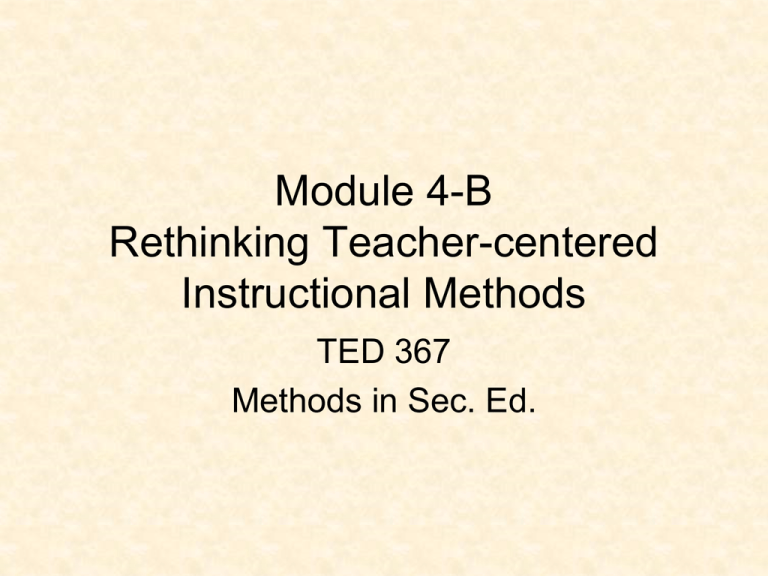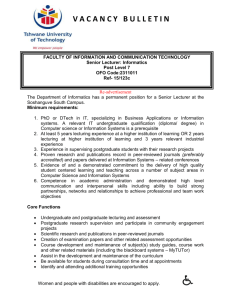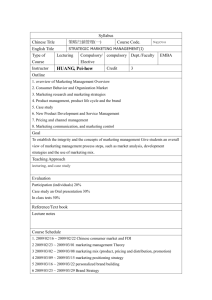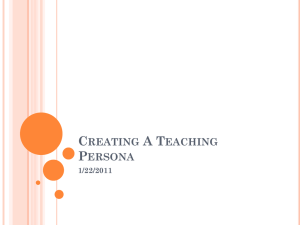Teacher-centered Methods
advertisement

Module 4-B Rethinking Teacher-centered Instructional Methods TED 367 Methods in Sec. Ed. Reading • Read the following in the Duplass textbook: – Unit 5 (topics 21-25) Instructional Approaches – Unit 6 (topics 26-36) Methods Teacher-centered Methods • Expository in nature. • Easier to implement than student-centered activities. Teacher-centered Methods 1. 2. 3. 4. 5. 6. 7. Teacher talk (lecturing) Demonstration Assignments and homework Memorizing Reviewing Questioning Discussion Topics in light color will be presented by class members. Teacher Talk (Lecturing) Teacher Talk (Lecturing) • If the traditional lecture method of “chalk and talk” with the teacher talking and pupils taking notes is your idea of teaching, you will find yourself with an inordinate amount of classroom management problems. Teacher Talk (Lecturing) • Lecturing (AKA direct instruction and teacher-centered instruction): – Teacher is THE primary communicator of knowledge. – Teacher directly manages the pace and sequence of instruction. – Includes: 1. Lecturing to students (formal). 2. Talking with students (informal). Teacher Talk (Lecturing) Teachers need to lecture more today due to time constraints in meeting academic standards. Teacher Talk (Lecturing) • Remember that: – You can “teach at” students, but this does not ensure students have learned the material. – You must monitor students to ensure that you have not lectured too long. Improving Teacher Talk • Newer approaches to teacher talk: – Feedback lecture. – Guided lecture. – Responsive lecture. – Demonstration lecture. – Pause procedure lecture. – Think/write/discuss. – Lecture with graphic organizer. – Socratic method lecture. Improving Lectures • Conduct lectures more as discussions. • Integrate different types of lectures and organizing patterns. • Integrate visuals and manipulatives into the lecture. When Lecturing, Make Sure… • • • • • Don’t talk too much. Don’t talk too fast. Make sure you can be heard and understood. Avoid monotone. Enthusiasm is contagious! Just because students hear something does not mean they understand it. – Don’t rely on lecture only. Support lecture with direct or simulated learning experiences. – Don’t assume. Ensure students know prerequisite knowledge/skills. Guidelines When Lecturing • Use an advance organizer. – State main idea and how it relates to other learning/knowledge. Builds connections. • • • • • • Have a beginning, end, and logical order. Reinforce with visuals. Encourage student participation. Have a clear ending, followed by activity. Keep teacher talk short. Keep pace relatively quick. Guidelines When Lecturing • Realize that the college lecture is inappropriate for adolescents. • Recapture student attention. – 10 to 15-minute blocks. Used to commercials. • Vary strategies and activities frequently: – Teacher talk student-centered activity – Change learning activities every 10-15 minutes. – In a 60-minute period, use 3 or 4 sequenced learning activities. May be concurrent. Guidelines When Lecturing • Prepare notes/outline. Do not read lecture! • Guide students in note-taking (what is important?). • Don’t just summarize textbook, or students will not read it. Augment and supplement. • Move about the room when lecturing. • Explain vocabulary as you go (prefix, root word, suffix). Remember that all teachers are language arts teachers! Guidelines When Lecturing • Use examples and analogies to bridge knowledge. • Establish and maintain eye contact. – Develops rapport. – Read student attentiveness and comprehension. – Helps with classroom management. Demonstration Demonstration • Demonstration is a methodology liked by students. • Students are actively engaged in the learning activity. Purposes of Demonstration • • • • • • Grabs attention of students. Student vicariously participates. Reduces safety hazards. Saves time and resources. Reviews theory. Illustrates or models. Guidelines when Demonstrating • Decide the most effective way to conduct the demo: – Teacher. – Teacher with student helper. – Student. – Entire class OR small groups. – Teacher first, then small groups repeat. Guidelines when Demonstrating • Make sure the demonstration is visible to all students. • Have a plan B. • Model proper safety precautions. Assignments and Homework Assignments and Homework Practice should be incorporated into the Instructional Sequence as either an inclass assignment and/or an out-of-class assignment (homework). Reason for Practice Automaticity: • Mastering Procedural Knowledge processes so that the procedure occurs rapidly and with little conscious effort. • Allows students to not commit substantial memory to the process. • Frees up cognitive capacity for higher level activity (reconstructing and making meaning of knowledge that is more complex). Overlearning: • How thinking processes become automatic. • Learn something to a point of mastery so that it can be replicated repeatedly, automatically, and over extended years. Types of Practice • Guided Practice ALWAYS takes place at school in a classroom, library, studio, laboratory, or computer room, where the teacher can observe and give feedback. • The teacher actively interacts with students, providing “over-theshoulder instruction” to an individual or group. • Tasks are graded. • Independent Practice can take place in school or as homework. • The student is expected to complete the task without (or with very little) assistance from the teacher, other students, or anyone else. • Independent Practice is also graded. Benefits of Homework • Improves academic performance & study habits. • Develops autonomy and self-discipline. • Promotes efficiency by effectively using both the classroom and the home for learning. • Facilitates parental involvement in children’s education. The Goals of Homework To practice skills learned in class. To learn a baseline of information in advance of a lesson, usually as a reading homework assignment. To apply concepts learned in the classroom by completing assignments. To learn self-discipline. Parents’ Duties 1. Provide a specific and consistent time each day for homework 2. If needed, designate a specific place where homework is to be done. 3. Limit distractions by eliminating TV and music during homework. 4. Check the student’s understanding of the assignment before he or she starts. 5. Encourage student to contact a study club member or homework buddy if needed. Parents’ Duties 6. Ensure student does not do homework with their friends (unless it is a group project). 7. If student encounters a problem, ask questions to help the student arrive at a conclusion. 8. Never do a teenager’s homework by telling him or her the answers. 9. Expect the work to be neat and orderly. 10. Check the work for accuracy Parents should if knowledgeable. not be viewed as a substitute for the teacher. Teachers’ Duties 1. 2. 3. 4. 5. Only assign homework that students should know how to do if they were paying attention in class. Reading assignments will follow a prereading activity and/or be followed by bell work or a postreading activity. Homework assignments will always be do-able and will not need any particular expertise to complete. Assignment will be clear and definite, and able to be completed without specialized materials. Students will be held accountable. Teachers’ Duties 6. 7. 8. 9. Students can be assigned to a study club or homework buddy to get assignments when absent and to clarify assignments. Amount of time students will be expected to spend on homework will be limited. (Maybe ½ hour a day, Monday through Thursday.) Meaningful homework will be assigned on a consistent basis, perhaps every Monday through Thursday. Homework will be collected, read, and graded, and feedback will be provided within two days of receipt. Include positive comments as well as notes about mistakes. Teachers’ Duties 11. Students can be prompted to use a homework planner. 12. Students—not the teacher—will be responsible for the daily check-in and checkout of homework. 13. There will be some mandatory and some optional homework. 14. There will be options: • For example, students will be able to choose between creating an essay or creating an image to express their ideas. 15. Assignments will be written on the chalkboard at the beginning of class, not at the end as an afterthought. 16. As students leave, they will be reminded about the homework due the next day. Memorizing Memorizing • Sometimes students must memorize things, even without much understanding. – Language alphabet – Math numbering system – Chemistry common element symbols – Play trumpet fingerings Guidelines for Memorizing Avoid overuse of memorizing. If possible, have students understand meaning before memorizing. Use mnemonics to aid students in memorization. Reviewing Reviewing • In general, reviewing is a positive and necessary practice! – Recall is improved. – Understanding is improved by strengthening semantic networks. Reviewing in Subjects • Science – Many concepts cannot be fully understood in isolation. – More appreciation for concepts when seen in context of later topics. • Math – Concepts build on each other. Frequent reviews are necessary. • Geography – Parts have less direct connection. Fewer reviews are needed. End of Unit/Course Review • Always profitable! – Helps to unify concepts. – Helps students see the big picture. – Helps strengthen semantic networks. • Review should not be used solely as preparation for an exam. If you review more often than just before an exam, students will not view a review as merely an exam preparation strategy. Alternative Review Techniques • • • • • • Student summaries Quiz games (Jeopardy) Discussion Broad questioning Dramatizations Application problems Explore: Game Reviews Online Game Templates Questioning Questioning • Well-formed questions help students develop their critical thinking skills. • Provides an opportunity for students to elaborate and adjust their responses based on their interaction with the teacher and other students, as well as to put forth unique insights. Questioning is one of the easiest ways to convert instruction from a passive to active learning experience, but it must be planned and purposeful. Structuring Effective and Efficient Questions 1. Knowledge questions check only memory: – What is an amoeba, and what are some of its critical attributes? 2. Comprehension questions check memory and comprehension: – Please give the class an example of supply and demand and explain the difference? 3. Application questions student ability to apply knowledge – How do the concepts of protagonist and antagonist apply to Macbeth? Structuring Effective and Efficient Questions 4. Analysis questions require the student to scrutinize Knowledge – What conclusions did you draw from the evaporation of the water? 5. Synthesis questions require the student to combine Information Knowledge & draw conclusions – If you know the longitude and latitude of a place, what other things can you hypothesize about its location? 6. Evaluation questions require the student to use a set of criteria to make a reasoned judgment. – What are the most important criteria for selecting a president of the United States? FAQ In a Middle School Classroom, assign percentages based on the type of questions you think are most frequently asked by teachers in a typical class situation. 87.0% 1.______ 9.8% 2.______ 4.6% 3.______ 4.0% 4.______ Knowledge Analysis Synthesis Evalaution Creating an Environment Conducive to Questioning 1. Classroom interaction focuses on sustained examination of a few topics. 2. Students are given sufficient time to think before being required to answer questions. 3. The teacher presses students to clarify or justify their assertions. 4. The teacher models the characteristics of a thoughtful person. 5. Students are encouraged to generate original and unconventional ideas. Questions • All students are called upon on an equally frequent basis during a period of time. • Students’ assessment includes grades for success in answering questions and participation. Wait Time How many seconds do you estimate the average American, German and Japanese teacher gives of Wait Time? For this exercise, it is the time between when you call on a student and he/she answers. 2 Seconds American _________ 7 Seconds German _________ 11 Seconds Japanese _________ Positive Results of Wait Time 1. All students are motivated to prepare and develop answers. 2. Length and correctness of student responses increases. 3. Silence and “I don’t know” responses diminish. 4. Number of volunteered answers to ungrounded questions increases. Wait Time Approach Results 5. Scores on academic achievement tests increase. 6. Teachers tend to ask more higherlevel questions. 7. Classroom becomes a quieter and more civil community of learners. 8. Students become more active agents in their own learning. Best Practices for Questioning 1. Create and announce your questioning Framework at the first class. 2. Use wait time. If a student doesn’t answer, then: a) Repeat the question. b) Rephrase the question. c) Simplify the question. d) Ask a student to attempt to rephrase your question. e) Break the question down into its component parts. f) Make your question more specific. g) Ask students what it is about the question that they are finding difficult. Try to elicit some kind of a answer; don’t just move on to another student. Best Practices for Questioning 3. Ask all students an equal number of questions during the course of a week. 4. Prepare questions that focus on higher-order thinking. 5. Since answers to verbal questions are part of assessment, make sure they are reflected in students’ grades. 6. Call on other students to repeat a particularly good answer. 7. Avoid fill-in-the-blank questions. Best Practices for Questioning 8. Encourage students to answer to the class, not just to you. 9. Form questions that are precise and definite, not ambiguous. 10.Encourage students to ask qualifying questions. 11.Keep questions short and to the point. Best Practices for Questioning 12.Do not ask for trivial information. 13.Hold students accountable by expecting, requiring, and facilitating their participation and contributions. 14.Never answer your own questions! If the students know you will give them the answers after a few seconds of silence anyway, there isn’t an incentive. Best Practices for Questioning 15.Establish a safe atmosphere for risktaking: a)Praise correct answers. b)Always respect incorrect responses by saying something positive about students’ efforts. c) When students make mistakes, ask followup questions designed to help them correct themselves. d)Model how to think about a question. Discussion Discussion • Leading an effective discussion can be one of the most difficult tasks of teaching. • It requires a commitment to a shared dialogue with the students and great restraint by the teacher, who naturally wants to work through his or her planned lesson. Best Practices in Discussion 1. At the beginning of the year have students discuss the nature of a good discussion. 2. Create a set of guidelines or rules for discussions that ensure civility. 3. Plan the discussion. What topics do you want to cover? In what order? What will you do if nobody says anything? 4. Create a stimulus, usually a provocative question, an emotionally laced statement, a proposition that on the surface appears to be a contradiction. Best Practices in Discussion 5. For the teacher, the focus is not on what you will say, but on how you will respond to students’ propositions and questions. 6. Use students’ comments as points at which you insert your planned agenda. 7. Use a combination of group and whole-class discussions. 8. Guide participation by rephrasing a statement by one student into a question for another. Best Practices in Discussion 9. If a class discussion is not going well due to lack of energy or enthusiasm, stop and discuss the situation with the students. 10. Discussion must be based on substantial knowledge. • Teacher needs to consistently ask the students to relate their comments to the content that was either read or viewed by them or presented in a lecture. 11. Use silence -- your own! • If you are silent, they will speak. Studies show that teachers dominate what are characterized as discussions almost as much as lectures. Best Practices in Discussion 12. Purposely slow the pace so that students sense they have time to reflect. 13. You are teaching both content and an Academic Disposition (you are modeling how to listen while being involved in a class discussion). 14. Rather than respond, ask another student what he or she thinks. Tips Teacher’s Tip If participation in the class is being dominated by a few students, give every student five rubber bands or paper clips. Each time a person speaks, he or she must throw a rubber band into a plastic bucket in the middle of the room. When students have used up their rubber bands, they can’t talk anymore until everyone has participated. Teacher’s Tip Don’t assume because it is a whole-class activity that you must lead the discussion. As an alternative, consider having one or two students lead the discussion while you join the class by taking a seat in one of the students’ desks. Review: MODULE 4-B 1. 2. 3. 4. 5. 6. 7. Teacher Talk (Lecturing) Demonstration Assignments and homework Memorizing Reviewing Questioning Discussion





